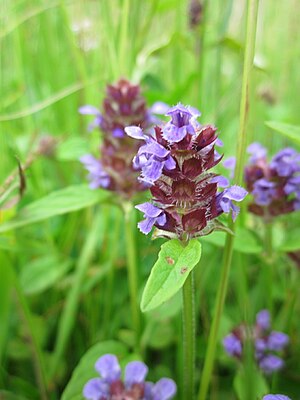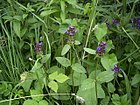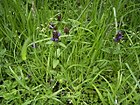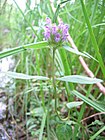Note: This is a project under development. The articles on this wiki are just being initiated and broadly incomplete. You can Help creating new pages.
Difference between revisions of "Prunella vulgaris - Self heal"
m (Prabhakar moved page Herbaceous plant (Prunella vulgaris) to Prunella vulgaris - Herbaceous plant) |
(→Identification) |
||
| (18 intermediate revisions by 2 users not shown) | |||
| Line 1: | Line 1: | ||
| − | [[File: | + | [[File:20130702Braunnelle St Arnual3.jpg|thumb|right|''Prunella vulgaris'', ''self-heal'']] |
| + | '''Prunella vulgaris''' is an herbaceous plant in the genus Prunella. | ||
| + | ==Uses== | ||
| + | {{Uses|High blood pressure}}, {{Uses|Fever}}, {{Uses|Weaknesses}}, {{Uses|Hemorrhoids}}, {{Uses|Vaginal pain}}, {{Uses|Conjunctivitis.}}, {{Uses|Sore throats}}, {{Uses|Diarrhea}}, {{Uses|Sore throats}}, {{Uses|Eczema }}, {{Uses|Psoriasis}}. | ||
| − | + | ==Parts Used== | |
| + | {{Parts Used|Whole herb}}. | ||
| − | + | ==Chemical Composition== | |
| + | Contains volatile oils, flavonoids, apigenin, luteolin, quercetin, kaempferol, tiliroside, triterpene glycosides including euscapic acid and tormentic acid, phenolic acids, and 3%–21% tannins.<ref name="chemical composition"/> | ||
| − | == | + | ==Common names== |
| − | + | {{Common names|kn=|ml=|sa=|ta=|te=|hi=|en=Herbaceous plant}} | |
| − | |||
| − | + | ==Properties== | |
| + | Reference: Dravya - Substance, Rasa - Taste, Guna - Qualities, Veerya - Potency, Vipaka - Post-digesion effect, Karma - Pharmacological activity, Prabhava - Therepeutics. | ||
| + | ===Dravya=== | ||
| − | + | ===Rasa=== | |
| + | Tikta (Bitter), Kashaya (Astringent) | ||
| + | ===Guna=== | ||
| + | Laghu (Light), Ruksha (Dry), Tikshna (Sharp) | ||
| + | ===Veerya=== | ||
| + | Ushna (Hot) | ||
| + | ===Vipaka=== | ||
| + | Katu (Pungent) | ||
| + | ===Karma=== | ||
| + | Kapha, Vata | ||
| + | ===Prabhava=== | ||
| − | + | ==Habit== | |
| + | {{Habit|Herb}} | ||
| − | == | + | ==Identification== |
| − | + | ===Leaf=== | |
| − | + | {{Leaf|Simple|Opposite|Leaves narrow-to ovate-oblong, to 5 x 2.5 cm, base cuneate, margin subentire, apex obtuse, pilose; petiole to 2 cm.}}<ref name="Leaf"/> | |
| − | |||
| − | |||
| − | == | + | ===Flower=== |
| + | {{Flower|Bisexual|Terminal spikes|Pinkish purple|4|Verticillate, to 3 x 2.5 cm(elongating to 5 cm in fruit), with flowers in whorls of 6; floral bracts leafy, ovate, to 6 x 4 mm, margin ciliate, purplish.}} | ||
| − | + | ===Fruit=== | |
| + | {{Fruit|Nutlet|||Oblong, smooth|}} | ||
| − | == | + | ===Other features=== |
| − | + | ||
| − | < | + | ==List of Ayurvedic medicine in which the herb is used== |
| − | < | + | |
| − | <ref name=" | + | ==Where to get the saplings== |
| − | <ref name=" | + | ==Mode of Propagation== |
| − | <ref name=" | + | {{Propagation|Seeds}}. |
| − | </references> | + | |
| + | ==How to plant/cultivate== | ||
| + | Easy to grow plant for any soil in full sun or partial shade. May be considered invasive. Attract bees and other beneficial insects. Good ground cover.<ref name="How to plant/cultivate"/> | ||
| + | |||
| + | ==Commonly seen growing in areas== | ||
| + | {{Commonly seen|Terrain region}}, {{Commonly seen|At grassland area}}, {{Commonly seen|Woodland edges}}, {{Commonly seen|At roadsides}}, {{Commonly seen|In wastelands}}. | ||
| + | |||
| + | ==Photo Gallery== | ||
| + | <gallery class="left" caption="" widths="140px" heights="140px"> | ||
| + | File:2016.06.18.-02-Bonadieshafen Friesenheimer Insel Mannheim--Kleine Braunelle.jpg | ||
| + | File:Gardenology.org-IMG 2829 rbgs11jan.jpg | ||
| + | File:Prunella_vulgaris_001.JPG | ||
| + | File:Prunella vulgaris Prague 2011 1.jpg | ||
| + | File:Prunella_vulgaris_3282.JPG|[[Anacortes Community Forest Lands]] | ||
| + | File:Prunella vulgaris plant1.jpg| | ||
| + | File:Prunella vulgaris plant2.jpg| | ||
| + | File:Prunella-vulgaris.jpg| | ||
| + | File:prunella_vulgaris_habitus.jpeg| | ||
| + | File:Prunella vulgaris bloemen.jpg| | ||
| + | </gallery> | ||
| + | |||
| + | ==References== | ||
| + | |||
| + | <references> | ||
| + | <ref name="chemical composition">[https://www.sciencedirect.com/science/article/pii/S0378874112006393?via%3Dihub Sciencedirect]</ref> | ||
| + | |||
| + | <ref name="Leaf">[https://indiabiodiversity.org/species/show/259346 Plant description]</ref> | ||
| + | |||
| + | <ref name="How to plant/cultivate">[https://www.rhs.org.uk/Plants/13944/Prunella-vulgaris/Details How to grow]</ref> | ||
| + | </references> | ||
| + | |||
| + | ==External Links== | ||
| + | * [https://www.gardeningknowhow.com/edible/herbs/self-heal/self-heal-prunella-vulgaris-plant.htm Growing Prunella: Tips For Growing The Common Self Heal Plant] | ||
| + | * [https://www.wildflower.org/plants/result.php?id_plant=prvu Prunella vulgaris on wild flower.org] | ||
| + | * [https://www.meadowmania.co.uk/news/grow-selfheal-prunella-vulgaris/ Prunella vulgaris on meadowmania.co.uk/] | ||
| + | * [https://www.herbal-supplement-resource.com/self-heal-herb.html Prunella vulgaris-Therapeutic Uses, Benefits and Claims of Self Heal] | ||
| − | |||
| − | |||
| − | |||
[[Category:Herbs]] | [[Category:Herbs]] | ||
| + | [[Category:Lamiaceae]] | ||
Latest revision as of 15:09, 22 July 2020
Prunella vulgaris is an herbaceous plant in the genus Prunella.
Contents
- 1 Uses
- 2 Parts Used
- 3 Chemical Composition
- 4 Common names
- 5 Properties
- 6 Habit
- 7 Identification
- 8 List of Ayurvedic medicine in which the herb is used
- 9 Where to get the saplings
- 10 Mode of Propagation
- 11 How to plant/cultivate
- 12 Commonly seen growing in areas
- 13 Photo Gallery
- 14 References
- 15 External Links
Uses
High blood pressure, Fever, Weaknesses, Hemorrhoids, Vaginal pain, Conjunctivitis., Sore throats, Diarrhea, Sore throats, Eczema , Psoriasis.
Parts Used
Chemical Composition
Contains volatile oils, flavonoids, apigenin, luteolin, quercetin, kaempferol, tiliroside, triterpene glycosides including euscapic acid and tormentic acid, phenolic acids, and 3%–21% tannins.[1]
Common names
| Language | Common name |
|---|---|
| Kannada | |
| Hindi | |
| Malayalam | |
| Tamil | |
| Telugu | |
| Marathi | NA |
| Gujarathi | NA |
| Punjabi | NA |
| Kashmiri | NA |
| Sanskrit | |
| English | Herbaceous plant |
Properties
Reference: Dravya - Substance, Rasa - Taste, Guna - Qualities, Veerya - Potency, Vipaka - Post-digesion effect, Karma - Pharmacological activity, Prabhava - Therepeutics.
Dravya
Rasa
Tikta (Bitter), Kashaya (Astringent)
Guna
Laghu (Light), Ruksha (Dry), Tikshna (Sharp)
Veerya
Ushna (Hot)
Vipaka
Katu (Pungent)
Karma
Kapha, Vata
Prabhava
Habit
Identification
Leaf
| Kind | Shape | Feature |
|---|---|---|
| Simple | Opposite | Leaves narrow-to ovate-oblong, to 5 x 2.5 cm, base cuneate, margin subentire, apex obtuse, pilose; petiole to 2 cm. |
Flower
| Type | Size | Color and composition | Stamen | More information |
|---|---|---|---|---|
| Bisexual | Terminal spikes | Pinkish purple | 4 | Verticillate, to 3 x 2.5 cm(elongating to 5 cm in fruit), with flowers in whorls of 6; floral bracts leafy, ovate, to 6 x 4 mm, margin ciliate, purplish. |
Fruit
| Type | Size | Mass | Appearance | Seeds | More information |
|---|---|---|---|---|---|
| Nutlet | Oblong, smooth | {{{6}}} |
Other features
List of Ayurvedic medicine in which the herb is used
Where to get the saplings
Mode of Propagation
How to plant/cultivate
Easy to grow plant for any soil in full sun or partial shade. May be considered invasive. Attract bees and other beneficial insects. Good ground cover.[3]
Commonly seen growing in areas
Terrain region, At grassland area, Woodland edges, At roadsides, In wastelands.
Photo Gallery
References
External Links
- Ayurvedic Herbs known to be helpful to treat High blood pressure
- Ayurvedic Herbs known to be helpful to treat Fever
- Ayurvedic Herbs known to be helpful to treat Weaknesses
- Ayurvedic Herbs known to be helpful to treat Hemorrhoids
- Ayurvedic Herbs known to be helpful to treat Vaginal pain
- Ayurvedic Herbs known to be helpful to treat Conjunctivitis.
- Ayurvedic Herbs known to be helpful to treat Sore throats
- Ayurvedic Herbs known to be helpful to treat Diarrhea
- Ayurvedic Herbs known to be helpful to treat Eczema
- Ayurvedic Herbs known to be helpful to treat Psoriasis
- Herbs with Whole herb used in medicine
- Herbs with common name in English
- Habit - Herb
- Index of Plants which can be propagated by Seeds
- Herbs that are commonly seen in the region of Terrain region
- Herbs that are commonly seen in the region of At grassland area
- Herbs that are commonly seen in the region of Woodland edges
- Herbs that are commonly seen in the region of At roadsides
- Herbs that are commonly seen in the region of In wastelands
- Herbs
- Lamiaceae










